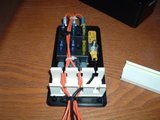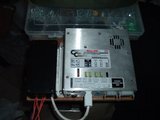Howdy guys. I'm working on a fairly ambitious project to outfit a Segway PT with quality warning equipment. The only systems I see currently used on Segways are small bicycle rigs. I'm instead wanting to go with vehicle-grade equipment. Two LINZ6s to the front, a LINZ6 to each side, two LINZ6s to the rear, a LIN3 tail light, and a Whelen 30 watt siren. This will all be powered by a 12V battery of some sort (haven't figured out exactly what type of battery I'll need yet) located in the handlebar bag. Most of the electrical connections will be located in a small electronics project box that will double as a switch box and mounting location for the front two LINZ6s.
I'm essentially looking for guidance with details such as power distribution, fusing, and connections. I'd like to keep this thread going as the project progresses, serving as a way for me to ask questions of the experts here and serving as a future resource for others who might find themselves faced with a similar project. I will post photos and updates here as things move forward. In the end I think it will be a very nice project, as I'm not looking to rush things and want to ensure that everything is done properly.
So, for the first dilemma I'm faced with as I map things out on paper...
Since there is no chassis ground on the Segway, I'll have to go straight from the negative battery terminal to the ULF44 flasher, various switches, and a few of the lightheads that won't be on the external flasher. What is the best and cleanest way to handle this ground distribution? I could easily just make multiple splices off a single wire (yes, I can solder), but it seems like there should be a better way to do it. Would it be redundant to use a fuse block for the ground distribution? Not sure where to go with this.
I'm essentially looking for guidance with details such as power distribution, fusing, and connections. I'd like to keep this thread going as the project progresses, serving as a way for me to ask questions of the experts here and serving as a future resource for others who might find themselves faced with a similar project. I will post photos and updates here as things move forward. In the end I think it will be a very nice project, as I'm not looking to rush things and want to ensure that everything is done properly.
So, for the first dilemma I'm faced with as I map things out on paper...
Since there is no chassis ground on the Segway, I'll have to go straight from the negative battery terminal to the ULF44 flasher, various switches, and a few of the lightheads that won't be on the external flasher. What is the best and cleanest way to handle this ground distribution? I could easily just make multiple splices off a single wire (yes, I can solder), but it seems like there should be a better way to do it. Would it be redundant to use a fuse block for the ground distribution? Not sure where to go with this.




